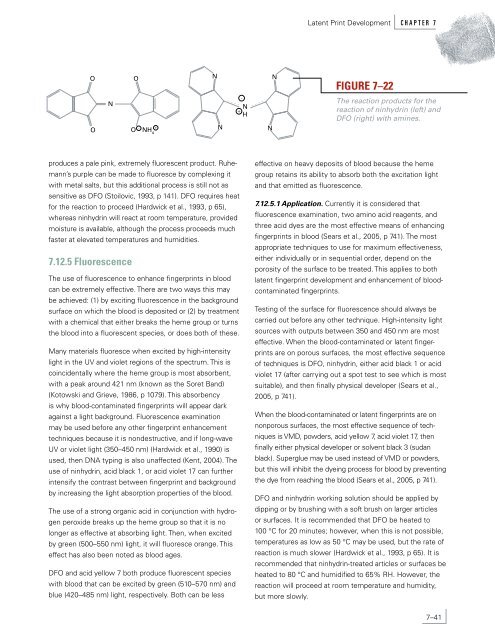Latent Print Development - National Criminal Justice Reference ...
Latent Print Development - National Criminal Justice Reference ...
Latent Print Development - National Criminal Justice Reference ...
Create successful ePaper yourself
Turn your PDF publications into a flip-book with our unique Google optimized e-Paper software.
O<br />
N<br />
O<br />
-<br />
O O NH4 produces a pale pink, extremely fluorescent product. Ruhemann’s<br />
purple can be made to fluoresce by complexing it<br />
with metal salts, but this additional process is still not as<br />
sensitive as DFO (Stoilovic, 1993, p 141). DFO requires heat<br />
for the reaction to proceed (Hardwick et al., 1993, p 65),<br />
whereas ninhydrin will react at room temperature, provided<br />
moisture is available, although the process proceeds much<br />
faster at elevated temperatures and humidities.<br />
7.12.5 Fluorescence<br />
+<br />
N<br />
N<br />
- - - -<br />
The use of fluorescence to enhance fingerprints in blood<br />
can be extremely effective. There are two ways this may<br />
be achieved: (1) by exciting fluorescence in the background<br />
surface on which the blood is deposited or (2) by treatment<br />
with a chemical that either breaks the heme group or turns<br />
the blood into a fluorescent species, or does both of these.<br />
Many materials fluoresce when excited by high-intensity<br />
light in the UV and violet regions of the spectrum. This is<br />
coincidentally where the heme group is most absorbent,<br />
with a peak around 421 nm (known as the Soret Band)<br />
(Kotowski and Grieve, 1986, p 1079). This absorbency<br />
is why blood-contaminated fingerprints will appear dark<br />
against a light background. Fluorescence examination<br />
may be used before any other fingerprint enhancement<br />
techniques because it is nondestructive, and if long-wave<br />
UV or violet light (350–450 nm) (Hardwick et al., 1990) is<br />
used, then DNA typing is also unaffected (Kent, 2004). The<br />
use of ninhydrin, acid black 1, or acid violet 17 can further<br />
intensify the contrast between fingerprint and background<br />
by increasing the light absorption properties of the blood.<br />
The use of a strong organic acid in conjunction with hydrogen<br />
peroxide breaks up the heme group so that it is no<br />
longer as effective at absorbing light. Then, when excited<br />
by green (500–550 nm) light, it will fluoresce orange. This<br />
effect has also been noted as blood ages.<br />
DFO and acid yellow 7 both produce fluorescent species<br />
with blood that can be excited by green (510–570 nm) and<br />
blue (420–485 nm) light, respectively. Both can be less<br />
-- - - - N<br />
+<br />
H<br />
N<br />
N<br />
<strong>Latent</strong> <strong>Print</strong> <strong>Development</strong> C H A P T E R 7<br />
FIGURE 7–22<br />
The reaction products for the<br />
reaction of ninhydrin (left) and<br />
DFO (right) with amines.<br />
effective on heavy deposits of blood because the heme<br />
group retains its ability to absorb both the excitation light<br />
and that emitted as fluorescence.<br />
7.12.5.1 Application. Currently it is considered that<br />
fluorescence examination, two amino acid reagents, and<br />
three acid dyes are the most effective means of enhancing<br />
fingerprints in blood (Sears et al., 2005, p 741). The most<br />
appropriate techniques to use for maximum effectiveness,<br />
either individually or in sequential order, depend on the<br />
porosity of the surface to be treated. This applies to both<br />
latent fingerprint development and enhancement of bloodcontaminated<br />
fingerprints.<br />
Testing of the surface for fluorescence should always be<br />
carried out before any other technique. High-intensity light<br />
sources with outputs between 350 and 450 nm are most<br />
effective. When the blood-contaminated or latent fingerprints<br />
are on porous surfaces, the most effective sequence<br />
of techniques is DFO, ninhydrin, either acid black 1 or acid<br />
violet 17 (after carrying out a spot test to see which is most<br />
suitable), and then finally physical developer (Sears et al.,<br />
2005, p 741).<br />
When the blood-contaminated or latent fingerprints are on<br />
nonporous surfaces, the most effective sequence of techniques<br />
is VMD, powders, acid yellow 7, acid violet 17, then<br />
finally either physical developer or solvent black 3 (sudan<br />
black). Superglue may be used instead of VMD or powders,<br />
but this will inhibit the dyeing process for blood by preventing<br />
the dye from reaching the blood (Sears et al., 2005, p 741).<br />
DFO and ninhydrin working solution should be applied by<br />
dipping or by brushing with a soft brush on larger articles<br />
or surfaces. It is recommended that DFO be heated to<br />
100 °C for 20 minutes; however, when this is not possible,<br />
temperatures as low as 50 °C may be used, but the rate of<br />
reaction is much slower (Hardwick et al., 1993, p 65). It is<br />
recommended that ninhydrin-treated articles or surfaces be<br />
heated to 80 °C and humidified to 65% RH. However, the<br />
reaction will proceed at room temperature and humidity,<br />
but more slowly.<br />
7–41

















